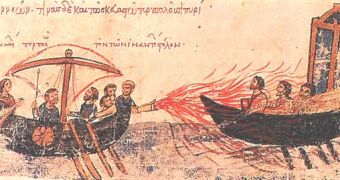Initially, Byzantium was a Greek city located on the European shore of the Bosporus strait, which separates Asia Minor from Europe. Understanding the importance of this settlement, surrounded from three parts by water, the Roman emperor Constantin re-founded this city in 330 AD, naming it by his name Constantinople. The city turned into a "New Rome" that governed the eastern part of the empire. The eastern part of the Roman empire still had resources and considerable wealth, fact that allowed it to stand the tough period that peaked with the fall of the western Roman empire in 476 AD.
The Eastern Roman Empire continued to govern the Balkans, Greece and the Mediterranean. Its rulers named it simply Empire, and hoped that they would recover the lost Western Roman Empire. This idea made Emperor Justinian (527-565 AD) to initiate a strong military movement which reconquered North Africa, Italy and southern Spain. Justinian made remarkable achievements; he amended the Roman Law, and he built towering constructions, like the Saint Sophia Church (today Hagia Sophia). The "Greek fire" (a mix of dry lime, petroleum, sulfur, which ignited in contact with the water), invented by 675 AD, allowed the control of the Byzantine fleet on the Mediterranean.
But the empire could not defend such long borders. In 568 AD, the Lombards (a Germanic tribe) conquered northern Italy, while troops had to be retreated from the west. In the east, the main enemy was the Sassanid Persia, but in 630 AD, an even higher danger emerged: the Muslim Arabs conquered Persia and defeated the Byzantine Empire, occupying Syria, Egypt and North Africa (former lands of the empire). Tunis was lost in 696 AD, and the Byzantine Empire was reduced to Asia Minor, Balkans, Sicily and southern Italy.
The new territory was easier to defend as the empire was more compact. The empire was "Roman" only because of the autocratic emperor and the legislation based on the Roman one. But the language and the culture were Greek, and the Christianity was of oriental type. With a well prepared army and reorganized as a "front line" state, Byzantium stood in front of the Muslims for 8 centuries. The key of the resistance was the defense system of the Constantinople, made of three walls which proved impenetrable for the Muslim troops. By those times, Constantinople was the largest and most superb city of the Christianity, the cradle of a culture and art whose refinement made the crusaders and royal courts of western Europe feel like mere provincials.
Between the East and West Christianity occurred also a religious rupture. Arabs had conquered the great dioceses of Antioch, Jerusalem and Alexandria. In this situation, Rome and Constantinople remained the only pretenders to the post of leaders of the Christianity and the disputes intensified. In Constantinople, the Emperor was the protector of the church, having direct authority over it, while in Rome, the pope's established Latin Church was independent from the state, sometimes being even its rival.
The religious disagreements gradually set apart the two churches and, in 1045, took place the Great Schism. This is how the Roman-Catholic Church of the west and the Orthodox Church of the east emerged. During the 9th and 10th centuries, Byzantine missionaries converted to Orthodoxism the Serbs, Bulgarians and Russians. A Golden Epoch for the Byzantium lasted from 867 to 1045, when the Imperial Armies occupied a great part of the Balkans and Middle East.
But during the 11th century, civil war started. Normands occupied southern Italy, while the Turks revived the Islam offensive. The Byzantine army was defeated in 1071 by the Turks at Manzikert; this was a turning point in the world's history: most of Asia Minor was lost, and with it the greatest human resources of the empire. Only internal fights of the Turks saved the Byzantium.
The empire asked for the help of the west, and the crusades started. The First Crusade (1096-1099) freed the Jerusalem and released the Byzantium from some external pressures, allowing it a short expansion. The emperor Basil II, the Bulgarian-Slayer, destroys the Bulgarian state in 1014. But in 1176, the Christian crusaders plunder the Constantinople. During the Fourth Crusade (1202-1204), the empire was transformed into a fragmented "Latin Empire."
In 1261, one of the surviving Greek principalities, led by Michael VIII the Paleologus, manages to defeat the Latins, remaking a mini-Byzantine Empire in western Asia Minor and Greece. But in 1340, a disastrous civil conflict allowed the Ottoman Turks to defeat the empire. The end was delayed because the Ottomans were involved in other fights. But on 29 May, 1453, the last emperor, Constantin XI, died on the walls of the Constantinople defeating the city, which was plundered by the Turks. A four-century-long Turkish terror was unleashed over central and eastern Europe.

 14 DAY TRIAL //
14 DAY TRIAL //